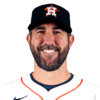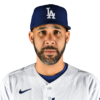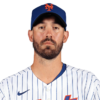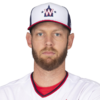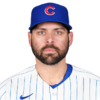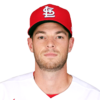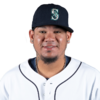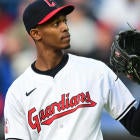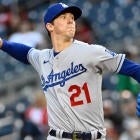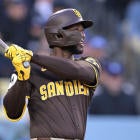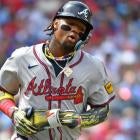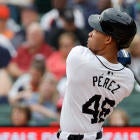Early 2017 rankings: 1B | 2B | 3B | SS | C | OF | SP | RP
Remember how a year ago, we were swimming in aces and couldn't decide if one was enough to sustain a Fantasy team?
About that ...
David Price struggled. Zack Greinke slumped. Chris Archer labored. Dallas Keuchel faltered. Matt Harvey imploded, then suffered a season-ending injury. Ditto Gerrit Cole. Stephen Strasburg, Jacob deGrom and Danny Salazar ended the year on the DL, but only after melting down first. Sonny Gray, Michael Wacha, Jordan Zimmermann, Adam Wainwright and Felix Hernandez fell off the map completely.
The result is pitchers like Rick Porcello, Kyle Hendricks and J.A. Happ in the thick of the Cy Young race even with less than ace-caliber peripherals.
¯\_(ツ)_/¯
Top 12 starting pitchers for 2017:
1. Clayton Kershaw, SP, Dodgers
2. Max Scherzer, SP, Nationals
3. Madison Bumgarner, SP, Giants
4. Chris Sale, SP, White Sox
5. Corey Kluber, SP, Indians
6. Justin Verlander, SP, Tigers
7. Jon Lester, SP, Cubs
8. Noah Syndergaard, SP, Mets
9. Jake Arrieta, SP, Cubs
10. David Price, SP, Red Sox
11. Yu Darvish, SP, Rangers
12. Johnny Cueto, SP, Giants
Even at the very top, Clayton Kershaw comes with an unfamiliar caveat. Are we just going to forget he missed a third of the season with a herniated disc that was never actually repaired? No doubt, his performance in September alleviated many of our concerns, but it didn't eliminate them. The back could flare up again, and if it does, you'll feel like you should have known better.
At the same time, he's the one pitcher who could put together a sub-2.00 ERA without it being a statistical anomaly. That's outlier dominance before even factoring in this year's offensive explosion. Without the back stuff, Kershaw might be the first player drafted at any position.
Among the pitchers who lasted the full season, Max Scherzer was clearly the best and has been in the running now four straight seasons. Likewise, Madison Bumgarner, Chris Sale and Corey Kluber have been good enough long enough that we shouldn't have any lingering doubts about them. So the top five is, in my estimation, pretty hard to argue.
But the sixth spot on this list? That's a different story ...
All right, first of many dilemmas ... which of these SPs do you want most in 2017? #FantasyBaseball
— Scott White (@CBSScottWhite) October 12, 2016
And which do you want least in 2017? #FantasyBaseball
— Scott White (@CBSScottWhite) October 12, 2016
Don't get me wrong: The polls show a clear favorite and a clear least favorite. So naturally, I've decided to ignore them and just pick who I wanted in the first place.
Sorry, but Justin Verlander was that good in the second half. He put together a 1.96 ERA, 0.86 WHIP and 10.9 strikeouts per nine innings in 16 starts, averaging about seven innings per. No other pitcher consistently delivered Scherzer-level volume and ratios. And yeah, we can sometimes make too much of partial-season numbers, but his overall numbers would make him my pick for AL Cy Young.
The argument against him would be that he fell out of the ace conversation for a couple years, but the turnaround actually began in the second half last year, when he put together a 2.80 ERA, 1.00 WHIP and 8.3 strikeouts per nine innings in 15 starts. A year-and-a-half of that kind of production is enough to win me back over.
Besides, the other choices all have their warts. Jon Lester is pretty steady, but his innings cap seems to be about 205, which is two starts short of most aces. Noah Syndergaard has the sizzling stuff and glowing peripherals, but I'm not sure we can quantify the havoc a 95-mph slider wreaks on an elbow. Until we see him throw 210 innings, I don't think we can just assume he will. Jake Arrieta battled control issues all year that seemed to intensify in the second half, when he put together a 3.69 ERA.
I wouldn't say I'm fearful of drafting any of those three, but we're talking a third- or fourth-round pick at this stage in the rankings. Better safe than sorry that early.
I guess the safe-than-sorry argument could also apply to Johnny Cueto, and I'm slotting two even riskier pitchers ahead of him. But he is the most hittable of this first group of 12. He could stay completely healthy and not perform like an ace, as we saw just last year, and before you David Price owners chime in, you need to recognize that Price's strikeouts, innings and wins (which aren't going anywhere pitching for the Red Sox) still made him the ninth-best pitcher in Head-to-Head points leagues and 16th-best in Rotisserie -- and that's before factoring in some normalization of his home run rate.
Yu Darvish is the one I might be selling short given that he returned from Tommy John surgery as dominant as ever, but after he threw just 132 1/3 innings this year -- majors, minors and playoffs combined -- I could see the Rangers messing with his workload next year.
Next 12 starting pitchers for 2017:
13. Jacob deGrom, SP, Mets
14. Stephen Strasburg, SP, Nationals
15. Carlos Carrasco, SP, Indians
16. Chris Archer, SP, Rays
17. Cole Hamels, SP, Rangers
18. Rick Porcello, SP, Red Sox
19. Kyle Hendricks, SP, Cubs
20. Zack Greinke, SP, Diamondbacks
21. Dallas Keuchel, SP, Astros
22. Danny Duffy, SP/RP, Royals
23. Jose Quintana, SP, White Sox
24. Matt Harvey, SP, Mets
And already, we're holding our breath at the position. Whatever risks you've attached to Verlander, Syndergaard, Arrieta, Price or Darvish are nothing compared to this group.
How many pitchers can we trust to perform at an ace level in 2017? Is it only 12, one for each team in a standard-size league? Because if that's the case, it won't take much for one owner, possibly you, to get left out in the cold.
That's a thin margin for error, not to mention a near requirement for you to draft a starting pitcher by the end of Round 3. And who wants to be handcuffed like that?
Granted, you don't have to be. Pitchers like Jacob deGrom, Stephen Strasburg, Carlos Carrasco and Chris Archer all have ace potential and would certainly qualify as fallback options. Heck, Rick Porcello was a top-five option in both formats this year. But it's a question of what you can reasonably expect. You draft these pitchers this early hoping they deliver their best-case scenario, but after the year that was, you can't count on it.
Not even for Porcello? Well, his 2016 really tested the limits of the "best-case scenario."
I'm not suggesting I wouldn't want him on my Fantasy team next year. He's an excellent control pitcher who has the game's top offense backing him and has proven he can throw 220-plus innings. But even if he's the exact same pitcher in every other measurement next year, he's not going 22-4 again. The thought is too improbable to even entertain. And judging by his BABIP and FIP, he's likely to regress in a couple other areas as well.
And while I'm at it, Kyle Hendricks, the NL's answer to "strikeouts aren't everything" (OK, so he's closer to Cueto than Porcello in that regard) won't have a 2.13 ERA. His FIP was a full run higher. Again, he does enough good for a good enough team that he'll still be valued in Fantasy, just not valued more than the 18 pitchers ahead of him.
But what about just the five ahead of Porcello and Hendricks? Why value them more? I'll tell you why ...
Accuse me of cherry-picking all you want, but these are these pitchers' stats in the starts leading up to the implosions that exposed their elbow injuries -- for deGrom, ulnar nerve damage and, for Strasburg, a strained pronator tendon -- thereby skewing their overall numbers. Strasburg, remember, looked like he'd run away with the NL Cy Young as late as mid-August.
Chris Archer, meanwhile, drastically reduced his walk rate over his final 13 starts, from 3.8 per nine innings to 1.9, leading to an ace-like 3.11 ERA, 1.00 WHIP and 10.4 strikeouts per nine innings, but the Rays were so busy finishing in last place that he didn't get the wins to show for it. Here's hoping for a trade, right?
As for Carrasco and Hamels, the former still hasn't proven he can throw 200 innings, but he battled a strained hamstring and a broken hand this year, which aren't the kind of injuries that would raise alarm for a pitcher. The latter added walk issues to his familiar home run issues but has been as steady of a presence in the top 20 as anyone.
The five after Porcello and Hendricks might actually be the more contentious group, though. Obviously, I'm counting on bounce-back seasons from Zack Greinke and Dallas Keuchel, who at least had stretches of success this year. Greinke's, unfortunately, weren't concentrated at the end, but he has the more impressive track record of the two even if he was kind of the Hendricks of 2015.
I have more confidence in both than Matt Harvey, who's recovering from a procedure (thoracic outlet surgery) that doesn't have the cleanest track record, but we've reached a point in the rankings where you can afford to gamble a little more. Harvey certainly has a Cy Young pedigree.
Next 12 starting pitchers for 2017:
25. Julio Teheran, SP, Braves
26. Masahiro Tanaka, SP, Yankees
27. Carlos Martinez, SP, Cardinals
28. Aaron Sanchez, SP, Blue Jays
29. J.A. Happ, SP, Blue Jays
30. Gerrit Cole, SP, Pirates
31. Michael Fulmer, SP, Tigers
32. Steven Matz, SP, Mets
33. John Lackey, SP, Cubs
34. Felix Hernandez, SP, Mariners
35. Rich Hill, SP, Dodgers
36. Tanner Roark, SP, Nationals
This third group of 12 begins with two of the most alike pairs at the entire position. Whether you prefer Julio Teheran and Masahiro Tanaka to Carlos Martinez and Aaron Sanchez, like I do, depends on whether you fear home runs or walks more. Because walks have the potential to impact both ERA and WHIP, I'll take the more homer-prone of the pairs.
Why Teheran over Tanaka? I still question Tanaka's durability even though he came close to 200 innings this year, and I don't expect the Braves to be significantly worse than the Yankees next year, if at all. Why Martinez over Sanchez? Well, he has done it more than just the one year, and I feel like he has just a little more strikeout potential.
And now for two more polls that show just how little I'm influenced polls:
Picking up with 2017 SP dilemmas, who you taking first?
— Scott White (@CBSScottWhite) October 13, 2016
And while I'm at it ...
— Scott White (@CBSScottWhite) October 13, 2016
People like them some Gerrit Cole -- and hey, ranking him 30th doesn't mean I don't. It just means I don't have a good enough understanding of what happened to him in 2016 to presume he'll be as good as new. Yes, he missed time with a strained triceps and, later, an inflamed elbow, but he wasn't pitching like an ace even before any of that came up. His slider wasn't as effective, and he stopped throwing it so much as a result. I do think some bad luck was at play, but I also don't know that he's out of the woods health-wise.
So even though I don't understand what happened to J.A. Happ in 2016 either (he seemed to abandon some of the changes he made under Ray Searage in Pittsburgh yet succeeded anyway), I feel like it's less likely to go disastrously wrong.
Michael Fulmer and Steven Matz, the best rookie pitchers from each league, are our best hope for the future and finished with surprisingly comparable numbers, but of course, Fulmer's innings cap was by design while Matz's was the result of a bone spur that he recently had removed.
Matz was the better strikeout pitcher of the two, but I think Fulmer will grow into more of one, judging by his raw stuff, and is better equipped to handle a full workload next year.
I may have subconsciously ranked John Lackey this low because I know I won't need to draft him any earlier. Nobody wants a 38-year-old with a career 3.88 ERA and 1.30 WHIP. But he just had a strikeout resurgence this year, not that he was terrible there to begin with, and he gobbles up innings for a stacked Cubs team. How do you not start that guy every week?
I suppose at 38, there's a more than decent chance he goes the way of Felix Hernandez, which sounds funny since Hernandez is all of 30 years old. But he has a ton of mileage on his arm, and it seemed to catch up to him this year, costing him another mile per hour on his fastball, and crippling all three of the ratios -- home runs, walks and strikeouts -- that most influence ERA. His 4.63 FIP suggests it could have been much worse, too.
Ranking him this high is nothing more than a nod to his adaptability and youth.
Inning for inning, Rich Hill was as good as any pitcher not named Kershaw this year, but of course, he had only 110 1/3 of those because of a recurring blister issue and, at 37 next year, is at risk of age regression while also having his innings managed. In some ways, he feels like even more of a Hail Mary than Hernandez.







